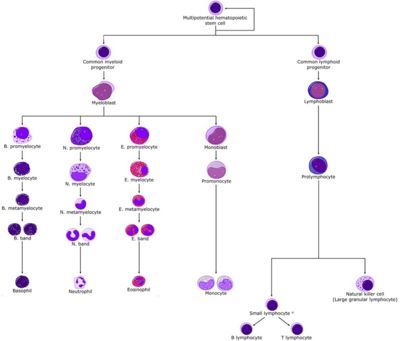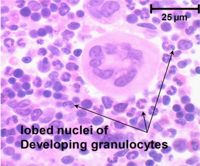Leukopoiesis
Leukopoiesis is the process of formation of leukocytes (white blood cells) from stem cells in haematopoietic organs. Leukocytes develop from either multipotential myeloid stem cells (CFU-GEMM) or multipotential lymphoid stem cells (CFU-L).
Leukocytes developing from CFU-GEMM’s are granulocytes (neutrophils, basophils and eosinophils) or monocytes and leukocytes developing from CFU-L's are lymphocytes (T & B cells, dendritic and NK cells).
Granulopoiesis
All granulocytes develop from the CFU-GEMM cells.
Summary of pathways
| Monocyte | Neutrophil | Basophil | Eosinophil | ©RVC 2008 | |
|---|---|---|---|---|---|
| Stem cell | CFU-GEMM | ||||
| CFU | CFU-M | CFU-G | CFU-Ba | CFU-Eo | |
| Factors | GM-CSF Il-3 M-CSF |
GM-CSF Il-3 G-CSF |
GM-CSF Il-3 |
GM-CSF Il-3 Il-5 | |
| Stages | Monoblast | Myelocyte | |||
| Promonocyte | Promyelocyte | ||||
| Monocyte | Neutrophilic Myelocyte | Basophilic Myelocyte | Eosinophilic Myelocyte | ||
| Neutrophilic Metamyelocyte | Basophilic Metamyelocyte | Eosinophilic Metamyelocyte | |||
| Band Cell | |||||
| Neutrophil | Basophil | Eosinophil | |||
Neutrophils
Under the stimulation of GM-CSF, G-CSF and Il-3 the CFU-GEMM differentiates into the CFU-GM, the common precursor for both neutrophils and monocytes. This then further differentiates into the CFU-G.
Stages
Myeloblast
Large cell with a large nucleus and stains basophilic. Same stage exists for all granulocytes.
Promyelocyte
During this stage primary (azurophilic) granules are formed. Same stage exists for all granulocytes.
Neutrophilic myelocyte
Developing neutrophil can now be differentiated from basophils and eosinophils as specific granules are now being formed.
Neutrophilic metamyelocyte
At this stage mitosis can no longer occur. The nucleus elongates, becomes heterochromatic and has a kidney like shape. Differentiation is now much clearer between other granulocytes as the specific granules are in a far greater number than the primary granules formed in the promyelocyte stage.
Band cell
Nucleus elongates further and represents a horse shoe. Nucleus starts to segment.
Neutrophil
Mature neutrophil is formed and the nucleus is segmented and has 3 to 5 lobes. This lobular structure of the nucleus gives rise to the name polymorphonuclear neutrophil.
Basophils
Under the stimulation of GM-CSF and Il-3 the CFU-GEMM differentiates into the CFU-Ba.
Stages
Myeloblast & Promyelocyte
These stages are common to all granulocytes and no distinction can be made between different cell lines. See neutrophil stages for further information.
Basophilic myelocyte & metamyelocyte
Specific granules start to appear in the myelocyte stage and once the cell has reached the metamyelocyte stage it cannot undergo further mitosis.
Basophil
Final nuclear shape is masked by high density of granules.
Eosinophils
Under the stimulation of GM-CSF, Il-3 and Il-5 the CFU-GEMM differentiates into the CFU-Eo.
Stages
Myeloblast & Promyelocyte
These stages are common to all granulocytes and no distinction can be made between different cell lines. See neutrophil stages for further information.
Eosinophilic myelocyte & metamyelocyte
Specific granules start to appear in the myelocyte stage and once the cell has reached the metamyelocyte stage it cannot undergo further mitosis.
Eosinophil
Mature cell has a bilobed nucleus.
Monocyte development
Monocytes develop from the same precursor as neutrophils the CFU-GM. This then differentiates into the CFU-M under the influence of GM-CSF, IL-3 and M-CSF.
Stages
Monoblast
First stage after cell has differentiated into the CFU-M.
Promonocyte
Cell has a large nucleus and basophilic cytoplasm and consists of two populations:- One rapidly dividing and the other slowly dividing (acting as a reservoir).
Monocyte
Monocytes are incapable of mitosis and enter circulation. They have a large kidney shaped nucleus with a slightly basophilic cytoplasm.
Macrophage
Once the monocyte has entered tissue it differentiates into a macrophage.
Dendritic cells
Develop from the monoblast under the stimualtion of GM-CSF and IL-4 into an immature dendritic cell. This then develops into the mature dendritic cell under stimulation of TNF-α.
Lymphopoiesis
Lymphocytes develop from the CFU-L's. Those destined to become T cells leave the bone marrow and migrate to the thymus, and those destined to be B cells migrate to the spleen and GALT or proliferate directly from the bone marrow.
Follow these links for a more detailed explanation on T cell development and B cell development.
| B cell | T cell | |||
|---|---|---|---|---|
| Differentiation | CFU-L | |||
| ▼Il-7 & Il-11 | ▼Il-7 & SCF | |||
| B lymphoid cell progenitor | T lymphoid cell progenitor | |||
| ▼Il-3 & Il-7 | ▼Il-7 | ▼Il-2, IL-12 & Il-18 | ▼Il-3, Il-6, GM-CSF & SCF | |
| Pre-B cell | Pre-T cell | Pre-NK cell | Pre-Dendritic cell | |
Maturation site |
Bone marrow, spleen or GALT Cloacal bursa (birds) |
Thymus | ||
| Mature | B cell ▼(Antigen stim.) Plasma & Memory cell |
T Cell Helper Cytotoxic Regulatory |
NK cell | Dendritic cell |
Note:
- That between the 'pre-[type] cell' stage and the final mature all the lymphocytes are referred to as 'immature [type] cells'.
- T cell differentiation into it's different forms (helper, cytotoxic and T cell with regulator functions) is under stimulation by Il-10 & TNF-γ

